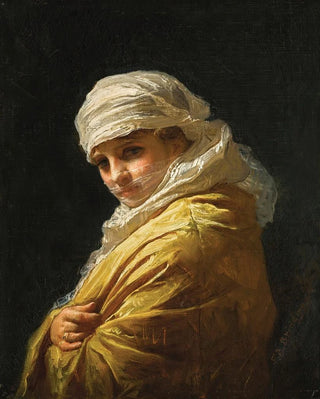Art print | Young woman with a white turban - Frederick Arthur Bridgman


View from behind

Frame (optional)
In the rich and captivating universe of art, certain works manage to capture the very essence of human beauty and culture. "Young Woman with a White Turban" by Frederick Arthur Bridgman is one of those remarkable pieces that, beyond its simple representation, evokes deep emotions and a captivating visual story. This painting, imbued with an intimate atmosphere, transports us to a world where light and color blend to create visual harmony. The artwork invites the viewer to explore the subtleties of human expression through the enigmatic gaze of its protagonist, while also sparking interest in the historical and cultural context of the period.
Style and uniqueness of the work
Bridgman's style is characterized by an exceptional mastery of light and shadow, which gives his portraits an almost lifelike dimension. In "Young Woman with a White Turban," the delicacy of the young woman's features, combined with the richness of textures, creates an impression of depth and realism. The white turban, a symbol of sophistication and mystery, immediately draws the eye and becomes the focal point of the composition. The shades of white, subtly enhanced by touches of color, evoke timeless softness and elegance. Every detail, from the fabric to the gaze, is treated with meticulous attention, revealing the artist's ability to translate complex emotions through the brush. This artwork does not merely depict a figure; it tells a story, that of a woman who is both strong and vulnerable, rooted in her era.
The artist and his influence
Frederick Arthur Bridgman, a 19th-century American artist, is recognized for his ability to fuse European influences with American sensibility. His artistic journey led him to travel across Europe and the Orient, enriching his work with a unique cultural diversity. Bridgman was able to capture the spirit of his time, during an era when art was turning toward the exploration of new subjects and techniques. His works, often inspired by oriental themes, testify to a fascination with exoticism and the beauty of distant cultures.

Matte finish

View from behind

Frame (optional)
In the rich and captivating universe of art, certain works manage to capture the very essence of human beauty and culture. "Young Woman with a White Turban" by Frederick Arthur Bridgman is one of those remarkable pieces that, beyond its simple representation, evokes deep emotions and a captivating visual story. This painting, imbued with an intimate atmosphere, transports us to a world where light and color blend to create visual harmony. The artwork invites the viewer to explore the subtleties of human expression through the enigmatic gaze of its protagonist, while also sparking interest in the historical and cultural context of the period.
Style and uniqueness of the work
Bridgman's style is characterized by an exceptional mastery of light and shadow, which gives his portraits an almost lifelike dimension. In "Young Woman with a White Turban," the delicacy of the young woman's features, combined with the richness of textures, creates an impression of depth and realism. The white turban, a symbol of sophistication and mystery, immediately draws the eye and becomes the focal point of the composition. The shades of white, subtly enhanced by touches of color, evoke timeless softness and elegance. Every detail, from the fabric to the gaze, is treated with meticulous attention, revealing the artist's ability to translate complex emotions through the brush. This artwork does not merely depict a figure; it tells a story, that of a woman who is both strong and vulnerable, rooted in her era.
The artist and his influence
Frederick Arthur Bridgman, a 19th-century American artist, is recognized for his ability to fuse European influences with American sensibility. His artistic journey led him to travel across Europe and the Orient, enriching his work with a unique cultural diversity. Bridgman was able to capture the spirit of his time, during an era when art was turning toward the exploration of new subjects and techniques. His works, often inspired by oriental themes, testify to a fascination with exoticism and the beauty of distant cultures.






